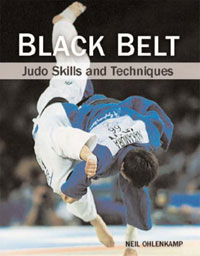Progressing in Judo
(An excerpt from the introduction to Judo Unleashed and Black Belt: Judo Skills and Techniques.)
Judo is difficult to learn. Fortunately, it can also be fun. Judo is designed to be an activity anyone can participate in: from schoolchildren to seniors, from the most fit athletes to those who need to get in shape, able-bodied or physically challenged, male or female, big or small.
All students go through well-defined steps to learn the basics, and there are clear methods for working towards mastery. Whatever your limitations, success in judo can be achieved. Some of that success will only come through hard work, but much of it will come while enjoying the games, drills, free practice and tournaments common to judo around the world. Judo students feel the exhilaration of succeeding through personal effort, the joy of achieving goals, and camaraderie with others facing the same battles.
Overcoming challenges is part of what makes judo so rewarding. Sprains, scrapes, sore muscles and bruised egos are common in classes where beginners are learning methods of attack and defence. Some people experience emotions brought on by fatigue, defeat or apparent lack of progress. Yet students also learn that obstacles of all types can be overcome, physical limitations can be extended, and fears can be faced. This is invaluable training for anyone striving to be a confident, successful person.
Learning judo is a growth process. As a beginner, you learn safety rules and falling skills. You progress to learning basic positions for throwing or pinning. When you feel confident in performing basic techniques, your training partner adds movement or resistance to make it more realistic, and you learn ways of defending against attacks. You then begin to make your moves more powerful and adaptable, and learn ways of combining techniques. Next you try to apply what you have learned in randori, in which your training partner tries to unbalance and weaken you. As you continue to learn more techniques and develop a greater depth of understanding of the techniques, you may be ready to test yourself in a tournament.
After each tournament or match you must re-examine your training, then redouble your efforts to study judo so you can perform better next time against an even more skilled opponent. Since every judo student is striving to improve, each brings other students along on the path to higher quality judo. You will continue to advance, perhaps exceeding your own expectations, because other students who are equally committed push you to be the best you can be.
 Rely on your sensei, or experienced instructor, to help and guide you as you advance. The sensei usually has a better perspective on your training than you do, and can observe and judge your progress, awarding ranks to recognize achievements.
Rely on your sensei, or experienced instructor, to help and guide you as you advance. The sensei usually has a better perspective on your training than you do, and can observe and judge your progress, awarding ranks to recognize achievements.
Judo is an endless path of self-discovery. It represents a journey with a definite beginning and middle, but no real end. The beginning is when you take your first few lessons, but the middle portion of the journey never ceases. A student who stays on the path will always be learning and advancing. Many judo masters continue to learn new things, and approach practice with the same awe and wonder they had as new students.
In judo you first learn to control your body, your emotions and your mind; only then can you control your opponent. It is exciting the first time you throw a resisting opponent spontaneously and without effort, or hold or control someone so that he or she cannot escape from you or hurt you. As you improve you will see that throws that seem difficult can actually be done effortlessly, even against opponents bigger than you. The more you understand about judo and the more you improve your skill level, the more fun judo is. Imagine how wonderful it feels when judo techniques come easily and they work on even the toughest opponents. This level of skill requires years of practice and is usually recognized by the black belt.